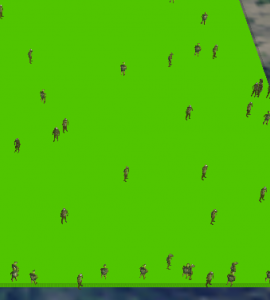
Original author
Resource type
Content area
Use type
Tools
Tags
Project name
Swords & Shields time needed: 30 - 45 minutes
Materials needed:
- Open space with perimeters marked (in dirt or with ropes)
- Computer(s) & projector
- Swords & Shields model
- CAST sheets for students.
Running the activity
- Tell the students that in “Swords & Shields” each student will play the role of an “agent” following a “simple rule.”
- Explain the simple rule. “Each person will pick someone else to be their sword and another person to be their shield. Do not tell anyone who you picked. When I say “GO” you must position yourself so your shield protects you from your sword” Also make sure you stay within the perimeter marked. Ask to make sure every one understands the rule.
- Pick two students to demonstrate the goal with. Show how as they move, you must move to stay in a “safe” position. Ask the students to predict what will happen when you say go.
- In the space scatter everyone then give them a little time to select a sword and a shield. Remind them not to tell anyone who they selected. Say “Go” and watch what happens.
- After a few minutes, say “Stop” and ask the students to look around. What do they see? What was the experience like from their perspective? Was the result what they predicted?
- Ask if any patterns or formations emerged, and if so, what were they?
- Ask if the same patterns would emerge if we played again? If we chose different people? If we scattered differently? What would be similar and what would be different?
- Play another round and see if the same pattern(s) result.
- Pick out a student and ask what factors determined his or her position. Usually students will say it is the position of their sword and shield (only). Then ask them what determines the position of their sword and their shield and they pick out more people. Following one of these links you can show how some people very far removed from you are actually influencing your position. Also sometimes the chain of influences comes all the way back to the person you started with.
- This is an example of a feedback loop in which the output of a system becomes its input.
Concluding the activity:
Return to the computers and show the Swords and shields model in StarLogo. What do they see? Are there different patterns ? Are they getting a different understanding of the system by seeing it from this perspective (overhead camera)? Are there patterns that are easier to see from this view?
Ask what they think would happen if you disturbed the system by dragging an agent out of its current position. Would the patterns form again?
Review some of the features of complex systems at the global scale: emergent patterns, adaptability, lack of leaders, feedback loops, and influences from afar.
Review the CAST at the board showing each circle and how zooming works.
- “At the individual scale… we see individuals”
- “At the local scale … we see interactions of individuals and/or the environment.”
- “At the global scale … we see emergent patterns, a view of whole system”
Using the CAST ask students what they see at the different scales in the Swords & Shields model. Have students answer and write notes on their individual CAST sheets labeled with “Swords & Shields”.
- At the individual scale… (individuals, with a sword and a shield)
- At the local scale … (interaction between individuals following a simple rule. Moving to meet some criterion.)
- At the global scale … (we see spirals and lines form (emergent patterns), over time turtles move to the edges (expansion.)
Questions:
- What is the influence of the environment?
- If we changed the rule to monkey in the middle (stay between two selected people), what would be the result?

